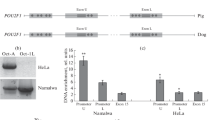Abstract
ZFPs (Zinc Finger Proteins) play important roles in various cellular functions, including transcriptional activation, transcriptional repression, cell proliferation, and development. C2H2 (Cys-Cys-His-His motif) ZFPs are the most abundant proteins among the founding members of the ZFP super family in eukaryotes. In this study, we isolate a novel C2H2 ZNF (Zinc Finger) gene ZNFD. It contains an ORF (Open Reading Frame) with a length of 990 bp, encoding 329 amino acids. The predicted protein contains a C2H2 zinc finger. RT–PCR analysis in 18 human adult tissues indicated that it was expressed in five human adult tissues. Green fluorescence protein localization analysis showed that human ZNFD was located in the nucleus of Hela cells. Overexpression of ZNFD in the COS7 cells activates the transcriptional activities of AP1(PMA) (Activator of protein 1, that responds specifically to phobol ester). Together the data indicate that ZNFD is probably a new type of C2H2 ZFP and the ZNFD protein may act as a transcriptional activator in PKC (protein kinase C) signal pathway to mediate cellular functions.






Similar content being viewed by others
References
Jeon BN et al (2009) ZBTB2, a novel master regulator of the p53 pathway. J Biol Chem 284:17935–17946
Khalfallah O et al (2009) Zinc finger protein 191 (ZNF191/Zfp191) is necessary to maintain neural cells as cycling progenitors. Stem cells 27:1643–1653
Yang Y et al (2009) The Kruppel-like zinc finger protein Glis3 directly and indirectly activates insulin gene transcription. Nucleic Acids Res 37:2529–2538
Ding G et al (2009) SysZNF: the C2H2 zinc finger gene database. Nucleic Acids Res 37:D267–D273
Rosenfeld R, Margalit H (1993) Zinc fingers: conserved properties that can distinguish between spurious and actual DNA-binding motifs. J Biomol Struct Dyn 11:557–570
Wu X et al (1995) Heart development in Drosophila requires the segment polarity gene wingless. Dev Biol 169:619–628
Al-Kandari W et al (2007) ZXDC, a novel zinc finger protein that binds CIITA and activates MHC gene transcription. Mol Immunol 44:311–321
Schuh R et al (1986) A conserved family of nuclear proteins containing structural elements of the finger protein encoded by Kruppel, a Drosophila segmentation gene. Cell 47:1025–1032
Klug A, Schwabe JW (1995) Protein motifs 5. Zinc fingers. FASEB J 9:597–604
Dai KS, Liew CC (1999) Chromosomal, in silico and in vitro expression analysis of cardiovascular-based genes encoding zinc finger proteins. J Mol Cell Cardiol 31:1749–1769
Lander ES et al (2001) Initial sequencing and analysis of the human genome. Nature 409:860–921
Venter JC et al (2001) The sequence of the human genome. Science 291:1304–1351
Clough RL et al (2009) Functional dissection of the alpha-synuclein promoter: transcriptional regulation by ZSCAN21 and ZNF219. J Neurochem 110:1479–1490
Leung SW et al (2009) Splice variants of the human ZC3H14 gene generate multiple isoforms of a zinc finger polyadenosine RNA binding protein. Gene 439:71–78
Dempsey EC et al (2000) Protein kinase C isozymes and the regulation of diverse cell responses. Am J Physiol 279:L429–L438
Stabel S, Parker PJ (1991) Protein kinase C. Pharmacol Ther 51:71–95
Newton AC (1995) Protein kinase C: structure, function, and regulation. J Biol Chem 270:28495–28498
Newton AC (1997) Regulation of protein kinase C. Curr Opin Cell Biol 9:161–167
Suzuki C et al (2008) A novel GDNF-inducible gene, BMZF3, encodes a transcriptional repressor associated with KAP-1. Biochem Biophys Res Commun 366:226–232
Messina DN et al (2004) An ORFeome-based analysis of human transcription factor genes and the construction of a microarray to interrogate their expression. Genome Res 14:2041–2047
Gao L et al (2004) Cloning and characterization of a novel human zinc finger gene, hKid3, from a C2H2-ZNF enriched human embryonic cDNA library. Biochem Biophys Res Commun 325:1145–1152
Li J et al (2007) ZNF307, a novel zinc finger gene suppresses p53 and p21 pathway. Biochem Biophys Res Commun 363:895–900
Berry N, Nishizuka Y (1990) Protein kinase C and T cell activation. Eur J Biochem 189:205–214
Gescher A, Dale IL (1989) Protein kinase C—a novel target for rational anti-cancer drug design? Anticancer Drug Des 4:93–105
Murray NR et al (1993) Protein kinase C isotypes in human erythroleukemia (K562) cell proliferation and differentiation. Evidence that beta II protein kinase C is required for proliferation. J Biol Chem 268:15847–15853
Hocevar BA et al (1992) Protein kinase C isotypes in human erythroleukemia cell proliferation and differentiation. J Cell Sci 101(Pt 3):671–679
Hocevar BA, Fields AP (1991) Selective translocation of beta II-protein kinase C to the nucleus of human promyelocytic (HL60) leukemia cells. J Biol Chem 266:28–33
Kraft AS et al (1986) Bryostatin, an activator of the calcium phospholipid-dependent protein kinase, blocks phorbol ester-induced differentiation of human promyelocytic leukemia cells HL-60. Proc Natl Acad Sci USA 83:1334–1338
Hocevar BA et al (1993) Identification of protein kinase C (PKC) phosphorylation sites on human lamin B. Potential role of PKC in nuclear lamina structural dynamics. J Biol Chem 268:7545–7552
Acknowledgments
This work was supported by the grant from the National Natural Science Foundation of China (Grant 30700826) and Medicine Development Foundation of Soochow University (EE134709).
Author information
Authors and Affiliations
Corresponding author
Rights and permissions
About this article
Cite this article
Lei, C., Liu, Q., Wang, W. et al. Isolation and characterization of a novel zinc finger gene, ZNFD, activating AP1(PMA) transcriptional activities. Mol Cell Biochem 340, 63–71 (2010). https://doi.org/10.1007/s11010-010-0401-1
Received:
Accepted:
Published:
Issue Date:
DOI: https://doi.org/10.1007/s11010-010-0401-1




